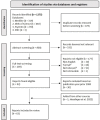How standardized are "standard protocols"? Variations in protocol and performance evaluation for slow cortical potential neurofeedback: A systematic review
- PMID: 36118975
- PMCID: PMC9478392
- DOI: 10.3389/fnhum.2022.887504
How standardized are "standard protocols"? Variations in protocol and performance evaluation for slow cortical potential neurofeedback: A systematic review
Abstract
Neurofeedback (NF) aims to alter neural activity by enhancing self-regulation skills. Over the past decade NF has received considerable attention as a potential intervention option for many somatic and mental conditions and ADHD in particular. However, placebo-controlled trials have demonstrated insufficient superiority of NF compared to treatment as usual and sham conditions. It has been argued that the reason for limited NF effects may be attributable to participants' challenges to self-regulate the targeted neural activity. Still, there is support of NF efficacy when only considering so-called "standard protocols," such as Slow Cortical Potential NF training (SCP-NF). This PROSPERO registered systematic review following PRISMA criteria searched literature databases for studies applying SCP-NF protocols. Our review focus concerned the operationalization of self-regulatory success, and protocol-details that could influence the evaluation of self-regulation. Such details included; electrode placement, number of trials, length per trial, proportions of training modalities, handling of artifacts and skill-transfer into daily-life. We identified a total of 63 eligible reports published in the year 2000 or later. SCP-NF protocol-details varied considerably on most variables, except for electrode placement. However, due to the increased availability of commercial systems, there was a trend to more uniform protocol-details. Although, token-systems are popular in SCP-NF for ADHD, only half reported a performance-based component. Also, transfer exercises have become a staple part of SCP-NF. Furthermore, multiple operationalizations of regulatory success were identified, limiting comparability between studies, and perhaps usefulness of so-called transfer-exercises, which purpose is to facilitate the transfer of the self-regulatory skills into every-day life. While studies utilizing SCP as Brain-Computer-Interface mainly focused on the acquisition of successful self-regulation, clinically oriented studies often neglected this. Congruently, rates of successful regulators in clinical studies were mostly low (<50%). The relation between SCP self-regulation and behavior, and how symptoms in different disorders are affected, is complex and not fully understood. Future studies need to report self-regulation based on standardized measures, in order to facilitate both comparability and understanding of the effects on symptoms. When applied as treatment, future SCP-NF studies also need to put greater emphasis on the acquisition of self-regulation (before evaluating symptom outcomes).
Systematic review registration: https://www.crd.york.ac.uk/prospero/display_record.php?ID=CRD42021260087, Identifier: CRD42021260087.
Keywords: brain computer interface (BCI); neurofeedback; self-regulation; slow cortical potentials (SCP); systematic review.
Copyright © 2022 Hasslinger, Meregalli and Bölte.
Conflict of interest statement
The authors declare that the research was conducted in the absence of any commercial or financial relationships that could be construed as a potential conflict of interest. Additionally, SB discloses that he has in the last 3 years acted as an author, consultant or lecturer for Medice and Roche. He receives royalties for textbooks and diagnostic tools from Hogrefe, and Liber. SB is shareholder in SB Education/Psychological Consulting AB and NeuroSupportSolutions International AB.
Figures


Similar articles
-
Effects of neurofeedback on the dysregulation profile in children with ADHD: SCP NF meets SDQ-DP - a retrospective analysis.Psychol Med. 2020 Jan;50(2):258-263. doi: 10.1017/S0033291718004130. Epub 2019 Jan 24. Psychol Med. 2020. PMID: 30674360 Clinical Trial.
-
Slow cortical potentials neurofeedback in children with ADHD: comorbidity, self-regulation and clinical outcomes 6 months after treatment in a multicenter randomized controlled trial.Eur Child Adolesc Psychiatry. 2019 Aug;28(8):1087-1095. doi: 10.1007/s00787-018-01271-8. Epub 2019 Jan 4. Eur Child Adolesc Psychiatry. 2019. PMID: 30610380 Clinical Trial.
-
One size fits all? Slow cortical potentials neurofeedback: a review.J Atten Disord. 2013 Jul;17(5):393-409. doi: 10.1177/1087054712468053. Epub 2012 Dec 20. J Atten Disord. 2013. PMID: 23264371 Review.
-
Slow cortical potential and theta/beta neurofeedback training in adults: effects on attentional processes and motor system excitability.Front Hum Neurosci. 2014 Jul 24;8:555. doi: 10.3389/fnhum.2014.00555. eCollection 2014. Front Hum Neurosci. 2014. PMID: 25104932 Free PMC article.
-
Predictors of neurofeedback training outcome: A systematic review.Neuroimage Clin. 2020;27:102301. doi: 10.1016/j.nicl.2020.102301. Epub 2020 May 28. Neuroimage Clin. 2020. PMID: 32604020 Free PMC article.
References
-
- Aggensteiner P.-M. M., Brandeis D., Millenet S., Hohmann S., Ruckes C., Beuth S., et al. . (2019). Slow cortical potentials neurofeedback in children with ADHD: comorbidity, self-regulation and clinical outcomes 6 months after treatment in a multicenter randomized controlled trial. Eur. Child Adolesc. Psychiatry 28, 1087–1095. 10.1007/s00787-018-01271-8 - DOI - PubMed
-
- Albrecht J. S., Bubenzer-Busch S., Gallien A., Knospe E. L., Gaber T. J., Zepf F. D. (2017). Effects of a structured 20-session slow-cortical-potential-based neurofeedback program on attentional performance in children and adolescents with attention-deficit hyperactivity disorder: retrospective analysis of an open-label pilot-approach and 6-month. Neuropsychiatr. Dis. Treat. Volume 13, 667–683. 10.2147/NDT.S119694 - DOI - PMC - PubMed
-
- Arnold L. E., Arns M., Barterian J., Bergman R., Black S., Conners C. K., et al. . (2021). Double-blind placebo-controlled randomized clinical trial of neurofeedback for attention-deficit/hyperactivity disorder with 13-month follow-up. J. Am. Acad. Child Adolesc. Psychiatry 60, 841–855. 10.1016/j.jaac.2020.07.906 - DOI - PMC - PubMed
Publication types
LinkOut - more resources
Full Text Sources
Miscellaneous

